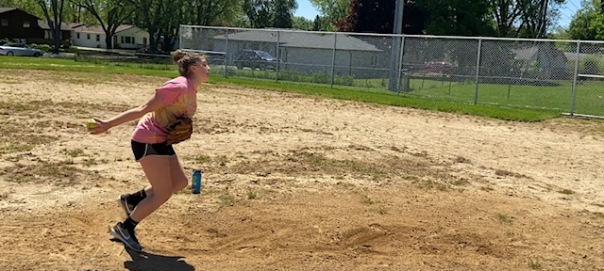
Here’s a quick experiment for you to try at home (or wherever you’re reading this blog). Try to move your arm away from the rest of your body. Pretty easy, right?
Now try a leg. Either one will do. Again, pretty easy.
Now do your head. If you go forward you can get it out there pretty far, and even side-to-side or backwards will work if you’re more flexible than I am.
Ok, here comes the key part: try moving your hips away. Aha! You can maybe get them out a couple of inches but that’s about it.
So basically, if your hips move away the rest of the body has to go with it.
This is a key concept for any fastpitch softball player to understand, but especially for pitchers. Many pitchers, when they are trying to get leg drive, will just run their stride leg past their drive leg and kick it forward. The result is that the stride leg pulls them off the pitching rubber – which is like trying to drag a wagon full of concrete behind you.
That’s because a lot of your weight (some of us more than others) and strength is carried in the hip area, which includes the lower torso. If it is stationary (more or less) it’s going to take a lot of effort to get it in motion so it can contribute to the pitch.
If the hips are already moving smartly forward as the pitcher drives out, however, instead of holding her back they add to the power. The difference (or delta as they like to say in the business world) can be huge.
The challenge is when pitchers think about moving forward, they tend to focus on their stride leg and where it lands. This leads to them doing more of a kicking motion instead of focusing their attention on where it should be – on the hips.
One way to help them get the feel of moving the hips forward (and how much effort it takes) is to have them do a standing broad jump. That is all about getting the hips and torso to fly forward.
Another way is to have them stand on one leg and then hop a short distance to the other. this can be front-to-back or side-to-side.
I say a short distance because as soon as you say long distance they’re going to go right back to reach out with the leg/foot instead of moving the middle.
A harness around their hips tied to a bungy cord or surgical tube will give them that feeling. Have them put the connector in the front, stretch the tube out as much as they can, then go through their pitching motion, letting the tube pull them forward.
You can also get behind them, place your hand on their lower back and give them a small push as they get read to go out. Just be careful that it’s a small push. You don’t want to push a pitcher who’s having trouble moving down to the ground (as I once did).
Ultimately, though, the best thing to do is get them to figure out how to get their hips moving forward to become part of the drive without all the artificial helpers.
As they start to get the feel of moving the hips properly, have them start pitching from a short distance into a net or screen. Keep them there until they can do it without thinking. then slowly move them back a few feet at a time and ensure they can maintain that hip-centered approach.
Only move to the next distance when they appear to have mastered the previous one. If they go back to being leg-oriented when they move back, move up to the previous position again. Repeat until they can throw properly at a full distance.
Incidentally, what I have found is that this is very easy and natural for some and very difficult and alien for others. I have no idea why, because it comes naturally to me.
What I do know, however, is that it is essential to maximize speed. The more momentum you can crash into a firm front leg the more the arm whip will be accelerated, creating more energy to transfer into the ball. A pitcher who is being held back by her hips will struggle to attain her very best speed.
The best way to check this is using video, either on a dedicated camera or your phone set to a high speed (60 frames per second or more). The naked eye can be easily fooled, especially if the pitcher is doing whatever she does quickly.
But with video, you can see if the hips are passing quickly over the pitching rubber on their way forward or whether they hover over it as the arms and legs move forward. (The first one is correct.)
Once you can see what’s going on you can work to correct it. It probably won’t be easy, but the results will be worth it.
More...

